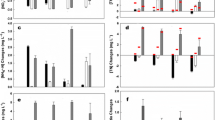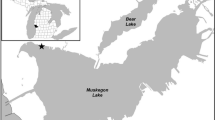Abstract
Variations in dissolved organic carbon (DOC) concentrations of surface waters and subsurface interstitial groundwater of riparian and wetland soils to 1.2 m depth were evaluated in a riverine wetland ecosystem over one year. DOC was monitored at seven sites within the wetland pond, two sites on the inflow stream, and one site on the outflow stream. Surface concentrations in the inflow stream ranged from 0.74 to 11.6 mg C L−1 and those of the outflow from 2.1 to 8.0 mg C L−1 Average DOC from stream floodplain hydrosoils (3.1 to 32.1 mg C L−1 was greater than DOC from the sediments below the stream channel (1.6 to 6.8 mg C L−1 Surface DOC within the wetland varied seasonally, with greatest fluctuations in concentrations through the summer and autumn (range 4.8 to 32.6 mg C L−1 ) during intensive macrophyte growth and bacterial production. DOC was less variable during the winter months (1.7 to 3.3 mg C L−1 Within the wetland pond, average DOC concentrations (7.1 to 48.2 mg C L−1) in the subsurface waters were significantly greater (p < 0.05) than average surface concentrations. The microbial availability of surface and subsurface DOC to bacteria was evaluated from losses of DOC by wetland bacteria grown on the DOC. Bacterial growth efficiencies ranged from 5 to 20% and were negatively correlated to the percentage of DOC removed by bacteria (r2=0.93). Throughout the ecosystem, DOC concentrations were greatest in the subsurface waters, but at most depths this DOC was a less suitable substrate than surface DOC for utilization by bacteria.
Similar content being viewed by others
References
Alberts JJ, Ertel JR & Case L (1990) Characterization of organic matter in rivers of the Southeastern United States. Verh. Intemat. Verein. Limnol. 24: 260–262.
Bicudo DC, Ward AK & Wetzel RG (1995) Fluxes of dissolved organic carbon within attached aquatic microbiota. Verh. Internat. Verein. Limnol. (In press).
Boissier JM & Fontvielle D (1993) Biodegradable dissolved organic carbon in seepage waters from two forest soils. Soil Biol. Biochem. 25: 1257–1261.
Briggs SV, Maher MT & Tongway DJ (1993) Dissolved and particulate organic carbon in two wetlands in southwestern New South Wales, Australia. Hydrobiologia 264: 13–19.
Carter S, Ward GM, Wetzel RG & Benke AC (1995) Population dynamics and productivity of the water lily Nymphaea odorata in a wetland ecosystem. Ecology (In review).
Dalva M & Moore TR (1991) Sources and sinks of dissolved organic carbon in a forested swamp catchment. Biogeochemistry 15: 1–19.
David MB, Vance GF & Kahl JS (1992) Chemistry of dissolved organic carbon and organic acids in two streams draining forested watersheds. Water Resour. Res. 28: 389–396.
Day JW Jr., Butler TJ & Conner WH (1977) Production and nutrient export studies in a cypress swamp and lake system in Louisiana. In: Wiley M (Ed) Estuarine Processes 2 (pp 255–269). Academic Press, New York.
Dosskey MG & Bertsch PM (1994) Forest sources and pathways of organic matter transport to a blackwater stream: a hydrologic approach. Biogeochemistry 24: 1–19.
Easthouse KB, Mulder J & Christophersen N (1992) Dissolved organic carbon fractions in soil and stream water during variable hydrologic conditions at Birkenes, Southern Norway. Water Resour. Res. 28: 1585–1596.
Fisher SG & Likens GE (1973) Energy flow in Bear Brook, New Hampshire: an integrative approach to stream ecosystem metabolism. Ecol. Monogr. 43: 421–439.
Ford TE & Naiman RJ (1989) Groundwater surface water relationships in boreal forest watershed: Dissolved organic carbon and inorganic nutrient dynamics. Can. J. Fish. Aquat. Sci. 46: 41–49.
Hendricks SP & White DS (1991) Physiochemical patterns within a hyporheic zone of a northern Michigan river, with comments on surface water patterns. Can. J. Fish. Aquat. Sci. 48: 1645–1654.
Ivarsson H & Jansson M (1994) Regional variation of dissolved organic matter in running waters in central northern Sweden. Hydrobiologia 286: 37–51.
Johnson MD & Ward AK (1995) Seasonal trophic dynamics of microbial communities in a lotic wetland ecosystem. Ecology (In review).
Kaplan LA & Newbold JD (1993) Biogeochemistry of dissolved organic carbon entering streams. In: Ford TE (Ed) Aquatic Microbiology. An Ecological Approach (pp 139–165). Blackwell Scientific Publications, Oxford.
Kaplan LA, Larson RA & Bott TL (1980) Patterns of dissolved organic carbon in transport. Limnol. Oceanogr. 25: 1034–1043.
Kirchman DL (1993) Leucine incorporation as a measure of biomass production by heterotrophic bacteria. In: Kemp PF, Sherr BF, Sherr EB & Cole JJ (Eds) Handbook of Methods in Aquatic Microbiology (pp 509–512). Lewis Publishers, Boca Raton, FL.
Kuserk FT, Kaplan LA & Bott TL (1984) In situ measures of dissolved organic carbon flux in a rural stream. Can. J. Fish. Aquat. Sci. 41: 964–973.
Linley EAS & Newell RC (1984) Estimates of bacterial growth yields based on plant detritus. Bull. of Mar. Sci. 35: 409–425.
Markosova R (1991) Growth of bacterioplankton on dissolved organic carbon in Hamilton Harbour and western Lake Ontario. Water Pollut. Res. J. Can. 26: 173–185.
McDowell WH & Likens GE (1988) Origin, composition, and flux of dissolved organic carbon in the Hubbard Brook Valley. Ecol. Monogr. 58: 177–195.
Meyer JL (1994) The microbial loop in flowing waters. Microb. Ecol. 28: 195–199.
Meyer JL, Edwards RT & Risley R (1987) Bacterial growth on dissolved organic carbon from a blackwater river. Microb. Ecol. 13: 13–29.
Middelboe M, Nielsen B & Søndergaard M (1992) Bacterial utilization of dissolved organic carbon (DOC) in coastal waters — determination of growth yield. Arch. Hydrobiol. Beih. Ergebn. Limnol. 37: 51–61.
Mulholland PJ & Kuenzler EJ (1979) Organic carbon export from upland and forested wetland watersheds. Limnol. Oceanogr. 24: 960–966.
Roden, EE & Wetzel RG (1995) Regulation of methane flux from freshwater wetland sediments by competing anaerobic microbial processes. Limnol. Oceanogr. (In review).
Servais P, Billen G & Hascoët M (1987) Determination of the biodegradable fraction of dissolved organic matter in waters. Water Res. 21: 445–450.
Servais P, Anzil A & Ventresque C (1989) Simple method for determination of biodegradable dissolved organic carbon in water. Appl. Environ. Microbiol. 55: 2732–2734.
Simon M & Azam F (1989) Protein content and protein synthesis rates of planktonic marine bacteria. Mar. Ecol. Prog. Ser. 51: 201–213.
SYSTAT for Windows: Statistics, Version 5 Edition. Evanston, Il: SYSTAT, Inc. (1992).
Thomaz SM & Wetzel RG (1995)3H-Leucine incorporation methodology to estimate epiphytic bacterial biomass production. Microbial Ecol. 29: 63–70.
Thurman EA (1985) Organic Geochemistry of Natural Waters. Nijhoff/Junk, Dordrecht 497 pp.
Tranvik LJ (1988) Availability of dissolved organic carbon for planktonic bacteria in oligotrophic lakes of differing humic content. Microb. Ecol. 16: 311–322.
Tranvik LJ & Höfle MG (1987) Bacterial growth in mixed cultures on dissolved organic carbon from humic and clear waters. Appl. Environ. Microbiol. 53: 482–488.
Vervier P & Naiman RJ (1992) Spatial and temporal fluctuations of dissolved organic carbon in subsurface flow of the Stillaguamish River (Washington, USA). Arch. Hydrobiol. 123: 401–412.
Wallis PM, Hynes HBN & Telang SA (1981) The importance of groundwater in the transport of allochthonous dissolved organic matter to the streams draining a small mountain basin. Hydrobiologia 79: 77–90.
Wetzel RG (1983) Limnology. 2nd ed. Saunders College Publ., Philadelphia 860 pp.
Wetzel RG (1984) Detrital dissolved and particulate organic carbon functions in aquatic ecosystems. Bull. Mar. Sci. 35: 503–509.
Wetzel RG & Likens GE (1991) Limnological Analyses. 2nd ed. Springer-Verlag, New York 391 pp.
Wetzel RG (1992) Gradient-dominated ecosystems: Sources and regulatory functions of dissolved organic matter in freshwater ecosystems. Hydrobiologia 229: 181–198.
Wetzel RG (1995) Death, detritus, and energy flow in aquatic ecosystems. Freshwat. Biol. 33: 83–89.
Wetzel RG & Howe MJ (1995) Population dynamics and productivity of the emergent rush Juncus effusus of a lotic wetland ecosystem. Ecology (In review).
Author information
Authors and Affiliations
Rights and permissions
About this article
Cite this article
Mann, C.J., Wetzel, R.G. Dissolved organic carbon and its utilization in a riverine wetland ecosystem. Biogeochemistry 31, 99–120 (1995). https://doi.org/10.1007/BF00000941
Received:
Accepted:
Issue Date:
DOI: https://doi.org/10.1007/BF00000941




